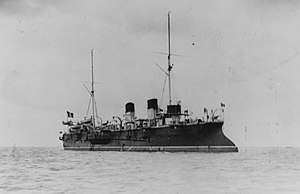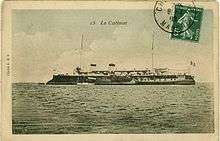French cruiser Catinat
Catinat was the lead ship of the Catinat class of protected cruisers built for the French Navy in the 1890s. The Catinat-class cruisers were ordered as part of a construction program directed at strengthening the fleet's cruiser force at a time the country was concerned with the growing naval threat of the Italian and German fleets. The new cruisers were intended to serve with the main fleet and overseas in the French colonial empire. Catinat was armed with a main battery of four 164 mm (6.5 in) guns, was protected by an armor deck that was 25 to 60 mm (0.98 to 2.36 in) thick, and was capable of steaming at a top speed of up to 20 knots (37 km/h; 23 mph).
 Catinat | |
| History | |
|---|---|
| Name: | Catinat |
| Ordered: | February 1894 |
| Builder: | Société Nouvelle des Forges et Chantiers de la Méditerranée |
| Laid down: | February 1894 |
| Launched: | 8 October 1896 |
| Completed: | 1898 |
| Stricken: | 1911 |
| Fate: | Broken up |
| General characteristics | |
| Class and type: | Catinat-class cruiser |
| Displacement: | 4,048 long tons (4,113 t) |
| Length: | 98.09 m (321 ft 10 in) pp |
| Beam: | 13.59 m (44 ft 7 in) |
| Draft: | 6.43 m (21 ft 1 in) |
| Installed power: |
|
| Propulsion: |
|
| Speed: | 19.5 to 20 knots (36.1 to 37.0 km/h; 22.4 to 23.0 mph) |
| Range: | 6,000 nmi (11,000 km; 6,900 mi) at 10 kn (19 km/h; 12 mph) |
| Complement: | 400 |
| Armament: |
|
| Armor: |
|
Completed in 1898, Catinat initially served with the Northern Squadron, where she conducted training exercises with the rest of the unit. She served in the unit for less than a year before being reduced to the reserve fleet. She was assigned to the Indian Ocean by 1901, remaining there for the next several years. By 1906, she had been transferred to France's colonies in the Pacific. Her career overseas was uneventful, and by 1911, she was struck from the naval register and thereafter sold for scrap.
Design
In response to a war scare with Italy in the late 1880s, the French Navy embarked on a major construction program in 1890 to counter the threat of the Italian fleet and that of Italy's ally Germany. The plan called for a total of seventy cruisers for use in home waters and overseas in the French colonial empire. The Catinat class was ordered as part of the program, and they were based on the earlier Descartes class.[1][2]
Catinat was 98.09 m (321 ft 10 in) long between perpendiculars, with a beam of 13.59 m (44 ft 7 in) and a draft of 6.43 m (21 ft 1 in). She displaced 4,048 long tons (4,113 t). Her crew numbered 400 officers and enlisted men. The ship's propulsion system consisted of a pair of triple-expansion steam engines driving two screw propellers. Steam was provided by sixteen coal-burning Belleville-type water-tube boilers that were ducted into two funnels. Her machinery was rated to produce 9,500 indicated horsepower (7,100 kW) for a top speed of 19.5 to 20 knots (36.1 to 37.0 km/h; 22.4 to 23.0 mph).[3] She had a cruising range of 6,000 nautical miles (11,000 km; 6,900 mi) at a speed of 10 knots (19 km/h; 12 mph).[4]
The ship was armed with a main battery of four 164 mm (6.5 in) guns. They were placed in individual sponsons clustered amidships, two guns per broadside. These were supported by a secondary battery of ten 100 mm (3.9 in) guns, which were carried in sponsons, casemates, and pivot mounts. For close-range defense against torpedo boats, she carried ten 47 mm (1.9 in) 3-pounder Hotchkiss guns and four 37 mm (1.5 in) 1-pounder guns. She was also armed with two 350 mm (14 in) torpedo tubes in her hull above the waterline. Armor protection consisted of a curved armor deck that was 25 to 60 mm (0.98 to 2.36 in) thick, along with 70 mm (2.8 in) plating on the conning tower.[3]
Service history

The contract for the ship was awarded to the Société Nouvelle des Forges et Chantiers de la Méditerranée shipyard in February 1894, with delivery due by February 1897.[5] Work on Catinat began with her keel laying later that month. She was launched on 8 October 1896 and was completed in 1898, well behind schedule.[3][6] She completed her sea trials by May that year.[7]
Catinat entered service in time to participate in the annual fleet maneuvers with the Northern Squadron in July and August 1898. The exercises took part in three stages; the first, a simulated blockade of the Baie de Douarnenez ended in the squadron's failure to contain the cruiser Surcouf and nine torpedo boats. The second consisted of an attack on the fortifications of Brest, and the third saw the fleet conduct an amphibious assault near Douarnenez.[8] While cruising off Boulogne on 17 August, the coastal defense ship Valmy ran aground and Catinat, the next vessel astern, was unable to turn in time to avoid colliding with her. Neither ship was seriously damaged in the accident, however, and Valmy was quickly re-floated.
Catinat initially remained assigned to the Northern Squadron in 1899. The unit was based in the English Channel, and at that time it consisted of six of the French Navy's older ironclads, a pair of armored cruisers, the protected cruiser Surcouf, and three smaller cruisers.[10] Catinat's tenure in the unit was brief, as she was reduced to the 2nd category of reserve by March, less than a year after completing her trials.
By January 1901, Catinat had been reactivated and assigned to the Naval Division of the Indian Ocean, which also included the unprotected cruisers D'Estaing and Nielly and the gunboat Scorpion.[12] Catinat served as the flagship on the unit, which was stationed in Madagascar.[13] She remained on the station in 1902 in company with the cruiser Infernet.[14] At some point thereafter, Catinat returned to France and was again placed in reserve for an overhaul. On 15 February 1905, she was recommissioned at Lorient for another tour overseas, this time to France's colonial holdings in the Pacific Ocean.[15] During a tour of the region in 1906, Catinat visited San Diego, California, in the United States in July. She exchanged salutes with the coastal fortification outside the city, along with visits with the commanding officer of the fort.[16]
She remained in the unit in 1907, by which time it had been amalgamated into the Far East Division, though Catinat continued to patrol France's colonies in the Pacific.[17] She remained on station in the Pacific in 1908, and in the two preceding years, she steamed a total of 75,000 nautical miles (139,000 km; 86,000 mi).[18] That year, the independent Pacific Naval Division was reestablished, with Catinat as its flagship; the unit also included the sloop Kersaint, the gunboat Zélée, and a pair of transports.[19] Catinat was struck from the naval register in 1911 and was subsequently sold to ship breakers.[6]
Notes
- Ropp, pp. 195–197.
- Gardiner, pp. 311–312.
- Gardiner, p. 312.
- Garbett 1904, p. 563.
- Dorn & Drake, p. 47.
- Gardiner & Gray, p. 193.
- Service Performed, p. 299.
- Leyland, pp. 213–215.
- Brassey 1899, p. 71.
- Jordan & Caresse, p. 219.
- Garbett 1901, p. 611.
- Brassey 1902, p. 52.
- Garbett 1905, pp. 321–322.
- Thompson, p. 49.
- Brassey 1907, p. 45.
- Brassey 1908, p. 53.
- Garbett 1908, p. 863.
References
- Brassey, Thomas A. (1899). "Chapter III: Relative Strength". The Naval Annual. Portsmouth: J. Griffin & Co.: 70–80. OCLC 496786828.
- Brassey, Thomas A. (1902). "Chapter III: Relative Strength". The Naval Annual. Portsmouth: J. Griffin & Co.: 47–55. OCLC 496786828.
- Brassey, Thomas A. (1907). "Chapter III: Comparative Strength". The Naval Annual. Portsmouth: J. Griffin & Co.: 39–49. OCLC 496786828.
- Brassey, Thomas A. (1908). "Chapter III: Comparative Strength". The Naval Annual. Portsmouth: J. Griffin & Co.: 48–57. OCLC 496786828.
- Dorn, E. J. & Drake, J. C. (July 1894). "Notes on Ships and Torpedo Boats". Notes on the Year's Naval Progress. Washington, D.C.: United States Office of Naval Intelligence. XIII: 3–78. OCLC 727366607.
- Garbett, H., ed. (May 1901). "Naval Notes: France". Journal of the Royal United Service Institution. London: J. J. Keliher & Co. XVI (279): 610–614. OCLC 1077860366.
- Garbett, H., ed. (May 1904). "Naval Notes: France". Journal of the Royal United Service Institution. London: J. J. Keliher & Co. XLVIII (315): 560–566. OCLC 1077860366.
- Garbett, H., ed. (March 1905). "Naval Notes: France". Journal of the Royal United Service Institution. London: J. J. Keliher & Co. XLIX (325): 321–325. OCLC 1077860366.
- Garbett, H., ed. (June 1908). "Naval Notes: France". Journal of the Royal United Service Institution. London: J. J. Keliher & Co. LII (364): 861–864. OCLC 1077860366.
- Gardiner, Robert, ed. (1979). Conway's All the World's Fighting Ships 1860–1905. London: Conway Maritime Press. ISBN 978-0-85177-133-5.
- Gardiner, Robert & Gray, Randal, eds. (1985). Conway's All the World's Fighting Ships: 1906–1921. Annapolis: Naval Institute Press. ISBN 978-0-87021-907-8.
- Jordan, John & Caresse, Philippe (2017). French Battleships of World War One. Annapolis: Naval Institute Press. ISBN 978-1-59114-639-1.
- Leyland, John (1899). Brassey, Thomas A. (ed.). "Chapter IX: Foreign Naval Manoeuvres". The Naval Annual. Portsmouth: J. Griffin & Co.: 210–218. OCLC 496786828.
- "Naval Notes: France". Journal of the Royal United Service Institution. London: J. J. Keliher & Co. XLII (247): 1091–1094. September 1898. OCLC 1077860366.
- "Naval Notes: France". Journal of the Royal United Service Institution. London: J. J. Keliher & Co. XLII (251): 190–193. 1899. OCLC 1077860366.
- Ropp, Theodore (1987). Roberts, Stephen S. (ed.). The Development of a Modern Navy: French Naval Policy, 1871–1904. Annapolis: Naval Institute Press. ISBN 978-0-87021-141-6.
- "Service Performed by French Vessels Fitted with Belleville Boilers". Notes on Naval Progress. Washington, D.C.: United States Office of Naval Intelligence. 20: 299. July 1901. OCLC 699264868.
- Thompson, Erwin N. (1991). The Guns of San Diego: San Diego Harbor Defenses, 1796-1947 : Historic Resource Study, Cabrillo National Monument. San Diego: National Park Service. OCLC 25772300.